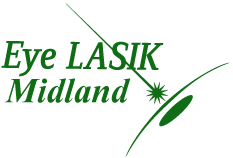by EyeLASIK | Aug 6, 2014 | Eye LASIK, laser vision correction surgery
Glaucoma is a fairly prevalent disease, affecting about two percent of the general population in the United States alone. It is actually the second leading cause of total blindness in the world. Glaucoma is known as the “silent thief” because it generally has no symptoms, and the disease is typically only noticed by the patient after extreme loss of peripheral vision has occurred.
What is Glaucoma?
Glaucoma is caused by an increase in pressure in the eye that causes damage to the optic nerve, the part of the eye that sends images received by the eye to the brain. This damage results in the gradual loss of peripheral vision that gets progressively worse and can lead to permanent blindness.
Glaucoma is usually diagnosed after a series of tests that include checking the pressure in the eye, looking at the optic nerve and checking for loss of peripheral vision. Once the disease has been diagnosed, treatment typically involves a regimen of eye drops to keep the pressure in the eye in a normal range. However, surgery can be an option if the drops do not control the pressure enough to prevent damage to the optic nerve.
But even if you’ve been diagnosed with glaucoma you can have laser eye surgery. Depending on the severity of your glaucoma, you may not be a candidate for traditional LASIK, but you may be able to have iLASIK with glaucoma.
iLASIK with Glaucoma
During the LASIK procedure, a hinged flap is made in the cornea (the clear part of the eye located in front of the iris) ,and then a laser is used to remove excess tissue in the corneal bed to refocus light and alleviate the patient’s need for glasses or contacts.
During a traditional LASIK procedure, a device called a microkeratome is used to cut the flap in the cornea. This part of the procedure can cause an increase in the pressure of the eye because the microkeratome uses suction to ensure the eye does not move while the flap is cut. This can exacerbate glaucoma in those patients with the condition, and in some cases, the pressure may go up even after the procedure has been completed.
However, iLASIK, also known as Intralase LASIK, alleviates this risk since the flap is created using a femtosecond laser. No pressure is placed on the eye to make the flap, and the procedure is completely bladeless. Instead during iLASIK with glaucoma, the femtosecond laser applies tiny rapid pulses of light to the eye causing microscopic bubbles to form just below the surface of the cornea.
The Intralase method takes about 15 seconds and makes having iLASIK with glaucoma safer for you. Having iLASIK with glaucoma also offers excellent results. Vision is typically clearer right after the procedure, and there is less trauma to the eye. The result is less inflammation after iLASIK with glaucoma along with a reduction in healing time.
For patients who thought they were unable to have laser eye surgery, iLASIK with glaucoma is a real possibility. For most patients, having iLASIK with glaucoma is a safe alternative to traditional LASIK.
Schedule a FREE evaluation to decide if laser vision correction surgery is for you. Read what happens at your evaluation in one of our past blogs here.
Want to receive more vision tips from Eye LASIK Midland? Register for our newsletter! Click HERE.

by EyeLASIK | Jul 31, 2014 | Healthy Vision San Angelo, LASIK San Angelo, Uncategorized
If you’re considering laser eye surgery, it’s imperative that you know the facts. There are a number of myths surrounding the procedure, despite the number of successful procedures performed yearly. Here we debunk five common myths laser vision correction surgery.
Myth #1: It’s Painful
It’s a very common misconception that laser eye surgery is painful in some way. This may be because it is a common fear for most people, but it is simply not the case.
During the procedure, your doctor will administer several drops of a topical anesthetic to numb your eyes. This will prevent any sensation of pain. In fact, the most uncomfortable part of laser eye surgery is the speculum used to hold your eye open during the procedure.
Myth #2: Surgery Results Aren’t Permanent
Laser eye surgery is a permanent treatment. The laser used to correct your vision removes a predetermined amount of tissue from your eye, which cannot grow back. If you notice that your vision is gradually starting to change, chances are it’s because you’re aging.
As you get older, your eyes age with you, which means at some point your vision will change and you will most likely need reading glasses. But this does not mean that your laser eye surgery wasn’t permanent, it simply means your eyes are getting older.
Myth #3: Results Take Time
With older procedures such as Radial Keratotomy, results were typically seen several days to weeks after the procedure. However, with laser eye surgery such as LASIK, results are typically seen immediately after the patient sits up from the procedure table.
However, in some cases, vision may be hazy or blurry for the first day or two. Because the cornea heals very quickly, most patients notice dramatic improvement in their vision within about 24 to 48 hours.
Myth #4: You’re Guaranteed 20/20 Vision
As with any surgery, there are no guarantees. However, with the advent of wavefront LASIK, the odds are much improved. For most patients, their final visual outcome depends on both the type of procedure and amount of correction needed. Because of this, it’s important to talk to your surgeon about your expectations before your procedure.
Myth #5: Laser Eye Surgery Is Risky
As with any procedure, there are risks with laser eye surgery. Halos, glare, or overcorrection are just some of the possible risks. Talk with your doctor about your specific concerns to put the risks in perspective.
Ready to take the first step towards better vision? Take advantage of our offer for a free consultation. You even get to see your local San Angelo doctor throughout the process. Click HERE or on the image below.


by EyeLASIK | Jul 30, 2014 | better vision, Eye LASIK, laser vision correction surgery
The first step in the LASIK procedure is the evaluation or consultation. During this appointment a trained eye doctor evaluates your results to ensure you’re a candidate for laser eye surgery. After a thorough discussion and exam, we’ll be able to determine if laser eye surgery is right for you. We’ll also recommend the best procedure based on your exam results. We perform a wavefront diagnosis using the WaveScan WaveFront system. Your eye is unique—as personal as your fingerprint or your DNA. The WaveScan WaveFront system creates a 3-D map that provides detailed information of your vision correction requirements to develop a personalized laser vision correction plan.
Want to read more about the different procedures! Check out our blog on LASIK vs. Epi-LASEK https://eyelasikmidland.com/epi-lasek-eye-surgery/
Please remember, it will be best to discontinue wearing your contact lenses several days before your evaluation appointment. Contact lenses distort the shape of your cornea, and we will want your cornea to have returned to it’s natural shape by the time of your appointment.
Ordinary defects in your vision can be corrected using eye glasses, contact lenses, and traditional LASIK surgery. Normal myopia, hyperopia, and astigmatism can be corrected using these traditional methods. However, there are irregularities of the eye that can only be spotted and treated with the Wavefront LASIK technology. The Wavefront LASIK will create an individualized laser correction program for the surface of your eye. This will be guided by a detailed analysis of the errors in your vision as seen in the way light travels through your eye.
Why does Eye LASIK Midland choose to use the Wavefront LASIK?
At Eye LASIK Midland we feel there are advantages to the Wavefront LASIK in terms of quality of your vision.
- There is a greater chance that you will achieve a twenty-twenty vision
- There is a greater chance that you will get better vision than twenty-twenty
- There is a lower chance of losing the optimal correction for your vision
- There is a lower chance of losing the quality in your vision
- There is a lower chance of losing sensitivity in terms of contrast
- There is a lower chance of getting glares
- It is unlikely that you will have problems seeing at night
There may be a chance to correct previous refractive surgeries and make seeing better with the custom LASIK refractive surgery.
Ready to make your FREE consultation with Eye LASIK Midland? Click HERE or on the image below.


by EyeLASIK | Jul 23, 2014 | better vision, Eye LASIK, laser vision correction surgery

Most people know the best ways to protect your body from harmful UV rays, but you may be forgetting about your eyes. Turns out your shades are more than a fashion statement. Sunglasses could help you avoid problems as varied as sunburn, cataracts and skin cancer.
Let’s look at a list of how specific areas of your eye are effected by the sun.
White of the eye
Sun damage can cause a condition called pinguecula, a thickening of the conjunctive, which is the clear, thin membrane that covers the white of the eye. This causes raised, yellow spots on the eye, near the cornea. While there’s no known danger to vision, it can get irritated and inflamed. The conjunctiva also thicken and grow over the cornea, creating a condition called pterygium (also known as surfer’s eye), which might obscure vision.
Iris
Research has suggested that blue-eyed people are more susceptible to macular degeneration, according to Brown. While at this point we don’t know the exact reason, it is recommended even more strongly that people with light eyes wear sunglasses.
Retina
The retina is a light-sensitive layer of tissue that lines the back of the eye. The macula is the part of the retina where we have straight ahead and detailed vision. That macula can start to deteriorate, causing a condition called macular degeneration, leading to blurred vision or a blind spot. Some information suggests there could be an association between UV light and macular degenation.
Lens
Behind the iris of the eye is a crystalline lens that helps to focus light onto the retina. That lens fan develop a cloudiness, whick is known as a cataract. UV light has been implicated in the development of some types of cataracts. The more you wear sunglasses and a hat, the longer you can put it off.
Cornea
Here’s a common summertime scenario: People go the shore for the day, and as they’re driving home their eyes feel kind of gritty, like maybe there’s sand in them. By 10 p.m. they’re in agony and by 11 they’ve landed in the ER for a sunburned cornea, which is a giant scratch on the cornea. While it doesn’t cause long term damage, it can cause tremendous pain and even temporary blindness.
Skin around the eyes
The skin around the eyes and, in particular, the eyelids are made up of a very thin tissue. Over time, repeated UV exposure (not to mention constant squinting) can lead to wrinkles and age spots, as well as small skin cancers around the eye.
With laser vision correction surgery you can ditch those glasses & contacts for a great pair of effective sunglasses. Schedule your FREE evaluation with Eye LASIK Midland today! Click HERE or by clicking in the image below.

by EyeLASIK | Jul 16, 2014 | Uncategorized
We all enjoy the independence that comes with a healthy body and mind. When your eyesight begins to fail we risk losing the ability to accomplish these activities we may take for granted. That’s why it’s important to so what you can to protect your valuable eyesight and do what you can to prevent common vision health problems.
With that in mind, here are 4 healthy vision facts you should know:
#1 Vision Health Fact:
Smokers, people with blue eyes, and postmenopausal women are particularly prone to lower levels of lutein making it critical to supplement with this proven nutrient for vision health. Check with your provider if lutein supplements should be added to your diet
#2 Vision Health Fact:
Environmental factors such as dry air and long hours in front of a computer, certain medications including antihistamines and decongestants, and simply aging can make us more susceptible to dry eyes. While there are many eye drop products designed to treat dry eyes, check with your provider for a product he/she may recommend to keep eyes moist and relieve dryness but will also help to prevent eye irritation from occurring in the first place.
#3 Vision Health Fact:
If you could add just one food to your daily diet to protect your vision, it should be spinach. In one study, women who ate spinach five times a week had a 45 percent reduction in risk of cataracts. Plus, another study found that men who consumed it twice a week had half the risk of cataract surgery compared to those who ate spinach less than once a month.
#4 Vision Health Fact:
Anthocyanosides—phytonutrients found in dark berries, especially bilberry and black currant—can improve by enhancing light/dark adaptation and reducing glare. The suggested daily dosages are 30 mg of bilberry extract and 200 mg of black currant extract. Again, This are just guidelines. We always recommend discussing any dietary changes with your provider.
Are you wondering if LASIK Eye surgery is for you? The best way to know is to schedule a FREE consultation. After our full evaluation, we’ll have all the information we need to make a recommendation and you’ll have everything you need to decide if LASIK is right for you! Click HERE or on the image below to schedule.








